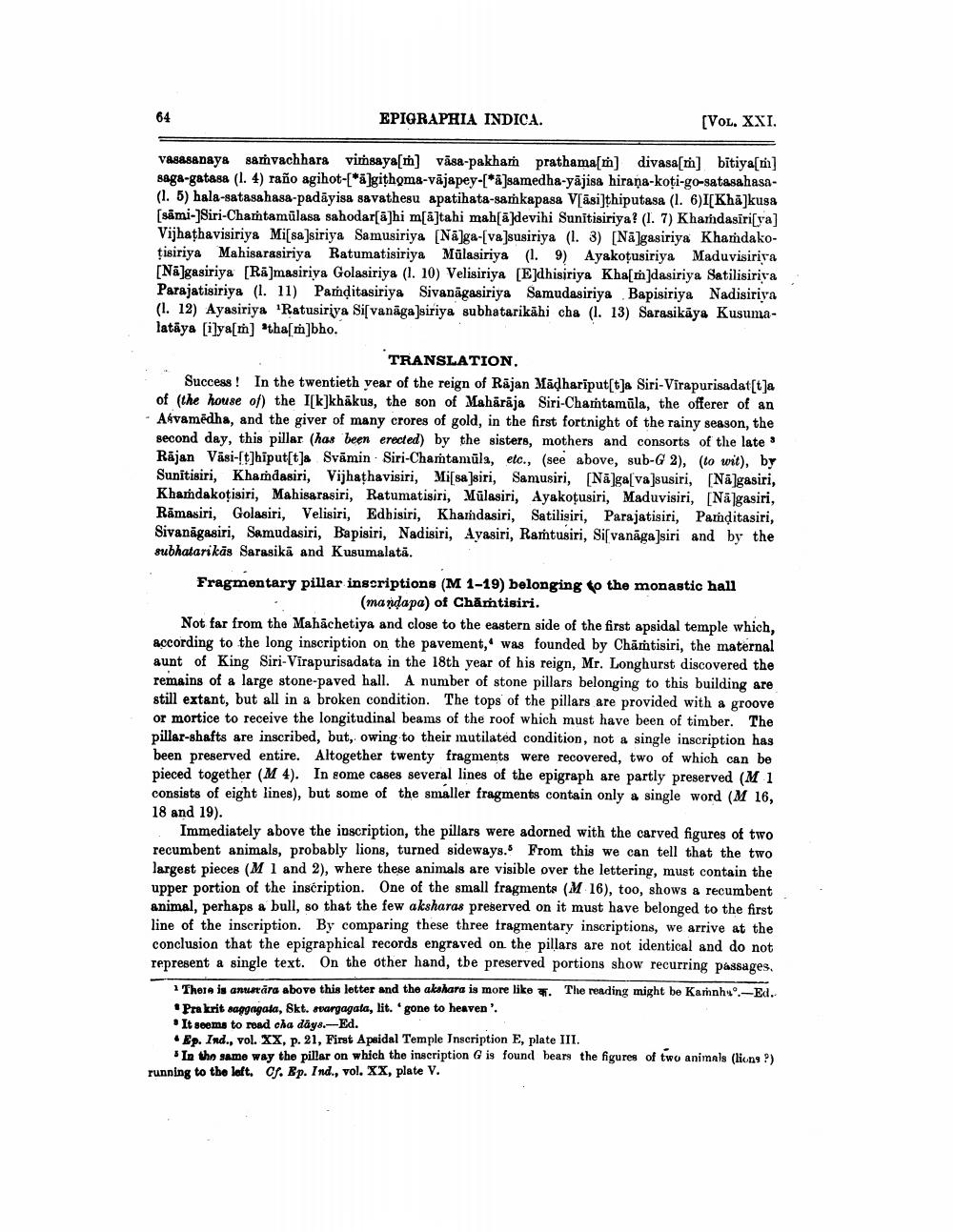________________
EPIGRAPHIA INDICA.
(VOL. XXI.
Vasasanaya samvachhara visaya[m] vāsa-pakham prathama[m] divasa[m] bitiya[m] saga-gatasa (1. 4) raño agihot-[*]githoma-vājapey-[*]samedha-yājisa hirana-koti-go-satasahasa(1. 5) hala-satasahasa-padāyisa savathesu apatihata-samkapasa V[äsi]thiputasa (1. 6)I[Khā]kusa [sâmi-]Siri-Chastamūlasa sahodarsā]hi m[a]tahi mah[@]devihi Sunītisiriya! (I. 7) Khardasīri[ya] Vijhathavisiriya Mi[sa]siriya Samusiriya [Nā]ga-[va]susiriya (1. 3) [Nā]gasiriya Khamdakotisiriya Mahisarasiriya Ratumatisiriya Mälasiriya (1.9) Ayakotusiriya Maduvisiriva Nálgagiriya Ra masiriva Golasiriya (1. 10) Velisiriya [E]dhisiriya Kha[m]dasiriya Satilisiriya Parajatisiriya (1. 11) Pamạitasiriya Sivanāgasiriya Samudasiriya Bapisiriya Nadisiriya (1. 12) Ayasiriya Ratusiriya Sif vanäga siriya subhatarikāhi cha (1. 13) Sarasikāya Kusumalatāya (ilya[m] 'tha[m]bho.
TRANSLATION. Success! In the twentieth year of the reign of Rājan Mādhariput[t]a Siri-Virapurisadat[t]a of the house of the Is[k]khäkus, the son of Mahārāja Siri-Chartamüla, the offerer of an - Akvamëdha, and the giver of many crores of gold, in the first fortnight of the rainy season, the
second day, this pillar (has been erected by the sisters, mothers and consorts of the late ' Rajan Väsi-[t]hiput[tja Svāmin Siri-Chamtamūla, etc., (see above, sub-G 2), (to wit), by Sunitisiri, Khandasiri, Vijhathavisiri, Mi[sa]siri, Samusiri, [Nā]galva]susiri, [Nā]gasiri, Khandakoțisiri, Mahisarasiri, Ratumatisiri, Müasiri, Ayakoţusiri, Maduvisiri, [Nā]gasiri, Råmasiri. Golasiri. Velisiri, Edbisiri, Khandasiri, Satilisiri, Parajatisiri, Parditasiri, Sivanagasiri, Samudasiri, Bapisiri, Nadisiri, Ayasiri, Raṁtusiri, Si[vanaga]siri and by the subhatarikās Sarasikā and Kusumalatā.
Fragmentary pillar inscriptions (M 1-19) belonging to the monastic hall
(mandapa) of Chāṁtisiri. Not far from the Mahāchetiya and close to the eastern side of the first apsidal temple which, according to the long inscription on the pavement, was founded by Chāṁtisiri, the maternal aunt of King Siri-Virapurisadata in the 18th year of his reign, Mr. Longhurst discovered the remains of a large stone-paved hall. A number of stone pillars belonging to this building are still extant, but all in a broken condition. The tops of the pillars are provided with a groove or mortice to receive the longitudinal beams of the roof which must have been of timber. The pillar-shafts are inscribed, but, owing to their mutilated condition, not a single inscription has been preserved entire. Altogether twenty fragments were recovered, two of which can be pieced together (M 4). In some cases several lines of the epigraph are partly preserved (M 1 consists of eight lines), but some of the smaller fragments contain only a single word (M 16, 18 and 19).
Immediately above the inscription, the pillars were adorned with the carved figures of two recumbent animals, probably lions, turned sideways. From this we can tell that the two largest pieces (M 1 and 2), where these animals are visible over the lettering, must contain the upper portion of the inscription. One of the small fragments (M 16), too, shows & recumbent animal, perhaps a bull, so that the few aksharas preserved on it must have belonged to the first line of the inscription. By comparing these three fragmentary inscriptions, we arrive at the conclusion that the epigraphical records engraved on the pillars are not identical and do not represent a single text. On the other hand, the preserved portions show recurring passages.
1 There is antara above this letter and the akahara is more like . The reading might be Karnho-Ed. • Prakrit naggagata, Skt. Hargagala, lit. gone to heaven'. . It seems to read cha days.-Ed. . Ep. Ind., vol. XX, p. 21, First Apsidal Temple Inscription E, plate III.
5 In the same way the pillar on which the inscription G is found bears the figures of two animals (ling?) running to the left. Cf. Bp. Ind., vol. XX, plate V.




